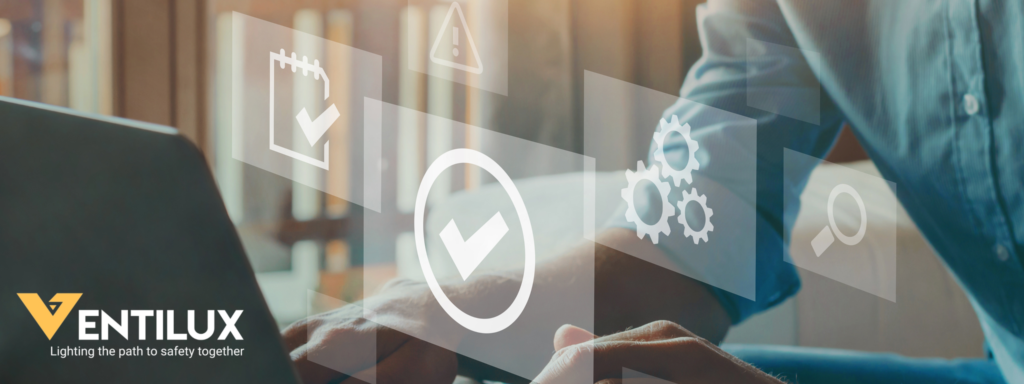Ensuring the safety of building occupants during an emergency hinges on the reliability of one crucial system: emergency lighting. Yet, understanding the standards governing emergency lighting systems can be challenging. These standards are not merely official hurdles; they are essential guidelines designed to save lives.
At Ventilux, we are committed to explaining these regulations to help our clients achieve compliance and peace of mind.
What are emergency lighting standards?
Emergency lighting standards outline the requirements for the design, installation, maintenance and performance of lighting systems intended to operate in emergencies. These systems ensure that occupants can safely exit a building in the event of a power outage, fire or other emergency.
In the UK and Europe, the key standards include:
- BS EN 1838: This specifies the lighting requirements for emergency escape lighting and standby lighting.
- BS 5266-1: The code of practice for emergency lighting in premises, which guides the design, installation, and operation of emergency lighting.
- BS EN 50172: This outlines the requirements for the provision, commissioning and maintenance of emergency escape lighting systems.
- BS 5266-1:2025: Set to be published later this year, this updated standard will introduce new guidelines to reflect advancements in technology and changes in building use. It is expected to place greater emphasis on the integration of sustainable and energy-efficient solutions in emergency lighting systems, as well as updated guidance for mixed-use buildings and dynamic lighting systems.

Each of these standards plays a vital role in ensuring that emergency lighting systems are effective, reliable, and compliant.
The primary purpose of emergency lighting is to ensure safety during an emergency. Compliance with standards ensures that:
- Escape routes are clearly illuminated: Proper lighting helps occupants identify escape routes quickly and reduces panic.
- Critical areas are safeguarded: Areas like stairwells, corridors, and exits must be well-lit to prevent accidents.
- Systems perform reliably: Standards ensure that emergency lighting systems activate automatically and perform effectively in critical situations.
Non-compliance can result in severe legal and financial consequences, as well as increased risk to life.
Critical aspects covered by the standards include:
- Illuminance levels: Standards dictate minimum lighting levels to ensure visibility. For example, BS EN 1838 specifies a minimum of 1 lux along escape routes and higher levels for specific areas like staircases and intersections.
- Duration of operation: Emergency lighting systems must remain operational for a specified duration, typically a minimum of one to three hours, depending on the building’s use and evacuation strategy.
- Placement and coverage: The correct placement of luminaires is crucial to avoid dark spots along escape routes. Standards like BS 5266-1 provide detailed guidance on luminaire positioning.
- Testing and maintenance: Regular testing and maintenance are mandatory under BS EN 50172. Monthly function tests and annual full-duration tests are critical to ensure system reliability.
Manual testing can be time-consuming and prone to human error. This is where Automatic Testing Systems (ATS), conforming to EN 62034, offer a significant advantage. These systems automatically conduct functional and duration tests at scheduled intervals, identifying faults in luminaires, batteries, and control circuits.
ATS not only ensures that emergency lighting remains operational when needed but also simplifies compliance by generating test reports and alerts, reducing maintenance costs. Whether self-contained or centrally monitored, ATS plays a vital role in guaranteeing reliability.
Navigating the standards
Navigating these standards can be complex, but that’s where we at Ventilux excel. With decades of expertise, we offer:
- Customised solutions: We design emergency lighting systems tailored to your building’s unique needs.
- Regulatory expertise: Our team stays up-to-date with the latest standards, ensuring your systems meet all requirements.
- Maintenance and support: From initial installation to ongoing testing and maintenance, Ventilux provides comprehensive support and expertise to keep your systems compliant.
At Ventilux, we believe that emergency lighting is not just about ticking boxes – it’s about creating safer environments for everyone. By adhering to these standards, you not only meet legal obligations but also demonstrate a commitment to the safety and well-being of building occupants.
If you’re unsure whether your emergency lighting systems meet current standards, contact us today for a consultation!



